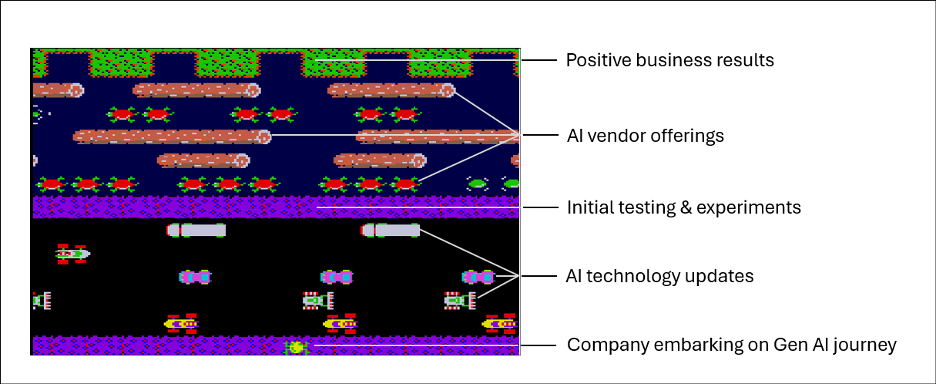Aplicativos de geração AI: Passando do experimento para a produção
Promessas, promessas. Aplicações habilitadas por IA generativa prometem aumentar a produtividade humana e, portanto, os lucros empresariais. O caminho do experimento à produção para muitos casos de uso continua frenético e perigoso, assim como o videogame de 1981 da Konami, Frogger . O sapo deve chegar em casa, primeiro atravessando uma rua movimentada e depois atravessando um rio de correnteza rápida. O sapo não consegue ficar parado, mas também não consegue pular para frente devido ao perigo inerente.
As empresas são o sapo. A rua e o rio são inundações vertiginosas de tecnologia de IA passando. Os espaços seguros (ruas abertas e troncos flutuantes) são projetos locais e ofertas de fornecedores. Carros, caminhões, tartarugas e águas abertas são os perigos éticos, legais, de privacidade e precisão da IA generativa. O lar é o lado oposto, onde os ganhos comerciais disparam após colocar aplicações de IA generativa em produção.
A velocidade com que a IA generativa decolou cria uma urgência frenética dentro das empresas. Mas a velocidade com que os modelos avançam pode paralisar algumas organizações porque o chão está se movendo tão rápido que elas não conseguem se orientar diante de mudanças constantes e rápidas. O segredo para adotar IA generativa é como começar um jogo de Frogger: comece!
Começando pelos casos básicos de uso de IA generativa, quando as empresas decidem quais deles parecem desejáveis, elas podem começar a experimentar. Seja criando um aplicativo habilitado para IA ou testando ofertas de terceiros, ou ambos, os testes iniciais esclarecerão exatamente o que a empresa precisa. A chave para o sucesso neste estágio inicial é comprometer-se com uma versão mínima do aplicativo que atenda aos requisitos de produção para segurança e eficácia. Isso se torna a base da organização. A partir daí, eles podem seguir em frente, decidindo quais avanços do modelo são importantes e se construir ou comprar é mais prudente.
Existem duas “pegadinhas” que inevitavelmente atrasarão uma organização que tenta adotar IA generativa: modelos de treinamento internos e repositórios de dados privados. O ritmo de avanço do modelo fundamental agora é medido em semanas e meses, e as versões posteriores são atualizadas diariamente. Dê uma olhada no rastreador de modelos HuggingFace se precisar de provas. A página que acabei de puxar enquanto escrevia este artigo preenche quase uma página inteira com modelos atualizados há menos de 1 minuto. É preciso rolar a tela para encontrar um modelo com mais de 2 minutos!
Se os dados necessários para responder a uma pergunta feita à IA estiverem disponíveis publicamente, é provável que já haja uma boa variedade de modelos fundamentais disponíveis por meio de uma API para uso. Por outro lado, se os dados não forem públicos, será necessário tomar uma decisão sobre se os dados devem ser enviados durante a inferência ou se um modelo deve ser criado, obtido e implantado de forma privada. Pagar para acessar um modelo é definitivamente mais rápido e provavelmente mais barato do que construir ou licenciar, hospedar e manter seu próprio modelo internamente. Qual é o seu superpoder corporativo? Se for algo diferente de construir ou manter grandes modelos de linguagem (LLMs), então é provável que você deva comprar, não construir e hospedar.
E para dados privados, as janelas de contexto e opções personalizadas para uso do LLM amadureceram tão rapidamente que a segurança e a conformidade de nível empresarial, semelhantes ao que já foi aceito para computação em nuvem, atendem aos requisitos da maioria das empresas. Na verdade, nenhum treinamento sobre seus dados foi ouvido alto e claro pelos provedores de modelos em 2023. Usando o ChatGPT Enterprise como exemplo, ele ostenta conformidade com SOC 2 Tipo 2, SAML SSO, criptografia de dados em repouso e em trânsito com espaços de trabalho dedicados que oferecem suporte à retenção de dados e verificação de domínio — nada mal, hein? Bem, para 92% das empresas da Fortune 500, parece ser bom o suficiente.
As organizações que acreditam nas promessas da IA generativa não precisam ficar paralisadas pelos perigos inerentes ou pelas melhorias diárias do LLM. Eles podem ter sucesso se mergulharem de olhos abertos. O ciclo inicial de experimentação traz confiança e a capacidade de priorizar quais tarefas se beneficiam mais com o uso seguro e ético. Elas devem ser implementadas em toda a organização no modo de produção, dando aos avaliadores e implementadores um descanso e tempo para a organização medir os ganhos de produtividade, priorizar o próximo conjunto de tarefas e determinar se faz mais sentido criar ou comprar acesso aos LLMs.

